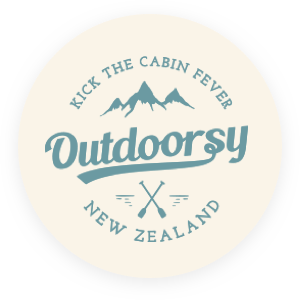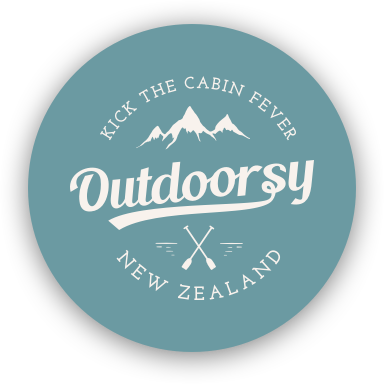The Hollyford Track, Fiordland
December 04 2018

How is it that there can be places which are completely overwhelming, and totally calming at the same time?
Recently, Mum and I hiked down the verdant Hollyford Valley. This gem of a track begins near Milford Sound in northern Fiordland, and emerges at the windblown coast of Martin’s Bay.
There are several DoC huts along the track, so if you are planning your own itinerary, you could plan for between 3-8 days out in the wild.
We went on a 3 day guided option with Hollyford Guided Walks (owned by Ngai Tahu tourism). The experience was enriched by the guides’ knowledge of the area – history, geology, botany…it really brought the landscape alive.
We began our trip in Queenstown, where we were picked up at the crack of dawn for a scenic bus trip to the start of the track, via the town of Te Anau.
On the track access road, we made a quick stop at Gunn’s Camp, a quirky little camping ground with cabins and tent sites right next to the river. The Gunn family have a lot of local history here, as we were to learn in the next few days! The adjoining museum/shop had a beautiful display of the rare ‘Bowenite’ pounamu or greenstone so precious to the Maori, which is found in the area. Several of the tracks here are part of the old trading routes.
A beautiful swing bridge, the first of many, welcomed us onto our track. We walked about 19 km through ancient rainforest, with the river bubbling alongside us on its mission to the ocean. Ferns uncurled, kamahi flowered, rimu soared overhead. Korimako (bell birds) chimed in the bush all around us, and the occasional kereru (native wood pigeon) crashed through the trees, noisily flapping its heavy wings. In the sand, the cloven hoofprints of deer led to the river, and if I closed my eyes I could imagine them there at dawn, drinking lazily and sniffing at the air of the new day.
Waterfalls tumbled down the valley walls and jostled over smooth river rocks. One cascade spilled down into a bowl so green and inviting that I had to strip off and leap in. Briefly. It was very cold, and oh-so refreshing.
That evening we were well looked after at Pyke Lodge, where the hosts had prepared us a hearty three course meal, and the views of the bush and the mountains were a peaceful prelude to a great night’s sleep. But not before a torch-lit adventure to feed some enormous eels, and wonder at a sparkling glow-worm grotto…memories were made.
Day two began with a quick side trip down to Lake Alabaster. We left our packs at the lodge and walked a few kilometres down the undulating track through the ferny forest. The morning was calm, quiet, and still; the lake pooled out before us and reflected all it could see. The mist gathered and broke, gathered and broke. We stared. It was literally breath taking.
Back at the lodge, we hoisted our packs and descended a short distance to the Hollyford River where we were met by our grinning jet-boat driver, Guy. We knew we were in for some fun!
The boat arced and sprayed across the shallows and through the rapids, the dark bush flashing by and our ears filled with the roar after so much silence. Once we burst out onto the calm waters of Lake McKerrow, we stopped and turned the engine off, going from one extreme of sound back to the other. We sat there for a while, drinking in the views, and our guides told stories of past floods and dramatic rescues. It was difficult to picture the raging torrents which are common in the area when we had such a tranquil day, but the forest debris from past events filled the shore lines, speaking their truth.
We stepped ashore briefly at the doomed settlement site of Jamestown. In the days of the goldrush, a road had been promised to transport the gold to the west coast, where a new port was planned to dispatch the riches across to Australia. The surveys were finalised around 1870, settlers moved in, and the track was begun from the western end. However, it soon became clear that the mountain route from Queenstown would be too expensive and difficult to build – and the gold was beginning to dry up. The plans were scuttled. The pioneers at Jamestown nearly starved as the steamers bringing supplies could seldom get ashore on the rough coast. One by one the families left, until only one remained – the MacKenzies, who moved across the river to a better farm site adjacent to the beach on the flats. This remarkable family stayed until the mid 1930s, in one of the most remote sites imaginable.
From Jamestown we hiked though the cleared river valley, thinking of those early farmers and the difficulties they faced. Childbirth, illnesses, accidents – there was no help to be had. They just got on with it. With these thoughts in our heads, we rounded a corner to find a cool safari tent completely set up with a delicious home baked lunch for us – such a surprise, and the gratitude was doubled by the stories we’d just been told. We later found out our lodge hosts for that evening had been the ‘lunch fairies’.
Fortified, we set off for the coast and the rocky shores of Long Point, where a permanent NZ fur seal rookery awaited. We pushed our way through thickets of flowering flax and climbed the boulders, finding spots to sit and observe the big bull males, snoozing mamas and playful pups from a distance. Dusk approached as we made our way back – but what was that jumping up onto the rocks? The rare Fiordland crested penguins were returning home from a days’ fishing, and we were treated to an encounter with three of them, preening, waddling, and screeching. The DoC hut near here would be a fabulous place to base yourself for a couple of days wildlife spotting.
We relaxed at Martin’s Bay Lodge that night with another enormous meal (fresh blue cod! Can’t beat it) and a family of cheeky kea (native mountain parrots) playing and feeding in the flax right outside the window. It was the first time I’ve ever seen them at sea level, but with the mountains close by they are regular visitors at Martins Bay, we were told. It’s heart breaking that the same cannot be said for the kakapo, which used to live here in the thousands. There is not one left here in the wild since the introduction of pests such as rats and stoats. There is a trapping program going on now, and kiwi are still around, but it was too little, too late for the kakapo which now only exists because of a captive breeding program.

On our final morning, we hiked the sand dunes and regenerating manuka forest to the old McKenzie farm. It was poignant to sit amongst the remains of their homestead, hearing the wind in the swaying eucalypts they planted. Amongst the eerie, wind swept dunes I could almost see and hear little children from the past, playing counting games with small stones, trailing sticks behind them, calling to the wind and to each other. Maori lived here for generations, the last chief Tutoko giving his name to the highest peak in the Darran range soaring up above the Hollyford. His daughters would have known each curve of the dunes. All those pioneer children with no local school to go to would have come here to escape their chores, letting the salt air fill their lungs, watching the wild waves in a storm from a safe distance. And there was me, trailing my stick, sorting through the stones, beach combing…
Returning to the lodge for lunch, I gathered my things and strapped an old piece of driftwood onto my pack. A weathered reminder of a place so full of texture. Two helicopters shattered the peace and circled, then landed on the lawn. As a final, spectacular end to an unforgettable trip, we launched into the blue and floated down the coast, over the alpine fault line, and then turned abruptly inward toward the towering cliffs. A tiny opening appeared as we banked left, and then the entire expanse of Milford Sound opened up before us, carved out by a glacier, immense, stupendous.
Fiordland is one of the most affecting places I have ever visited. Go there. Experience the Hollyford. Then plan your return.

